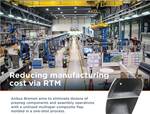CMF project's process combines prepreg with RTM
Composite Multispar Flap (CMF) project at Airbus Bremen demonstrates SQRTM process for producing aircraft flaps
In its goal to simplify production of outboard wing flaps for narrowbody aircraft, the Composite Multispar Flap (CMF) project led by Airbus Bremen (Bremen, Germany) demonstrated integrating 26 carbon fiber reinforced polymer (CFRP) parts into a one-piece structure injected and cured in a single-shot resin transfer molding (RTM) process. In addition to demonstrating production of the new CMF using a conventional RTM process with dry fabric and liquid resin, the Airbus Bremen team also demonstrated fabricating the part using the Same Qualified Resin Transfer Molding (SQRTM) process, developed by Radius Engineering (Salt Lake City, UT, US, see “SQRTM enables net-shape parts,”).
SQRTM uses a prepreg layup instead of a dry fabric preform, with the RTM process injecting the same resin that is used in the prepreg, but in liquid form. The benefit of this approach is that it avoids any need for qualifying new materials.
Why SQRTM? Because the CMF concept can be applied to other structures, such as an inboard wing flap. However, as Airbus Bremen’s industrial moveable architect Dr. Stefan Bauer explains, the inboard flap must sustain impacts from runway debris and, therefore, needs a toughened resin system. “We have no qualified toughened resin system for RTM,” he adds, “so the feasibility of SQRTM also was demonstrated within the CMF project on a full-scale 7.8m component with excellent results. The concept is mainly the same.” According to Bauer, both the dry fabric RTM and SQRTM process variants are ready for industrialization.
This short article is a sidebar to a feature article titled, "Reducing manufacturing cost via RTM".
Related Content
-
Carbon fiber composite pallet revolutionizes freight industry
LOG Point Pallet fuses advanced materials with innovative design and manufacturing to improve supply chains worldwide.
-
Sulapac introduces Sulapac Flow 1.7 to replace PLA, ABS and PP in FDM, FGF
Available as filament and granules for extrusion, new wood composite matches properties yet is compostable, eliminates microplastics and reduces carbon footprint.
-
Composites end markets: New space (2025)
Composite materials — with their unmatched strength-to-weight ratio, durability in extreme environments and design versatility — are at the heart of innovations in satellites, propulsion systems and lunar exploration vehicles, propelling the space economy toward a $1.8 trillion future.



